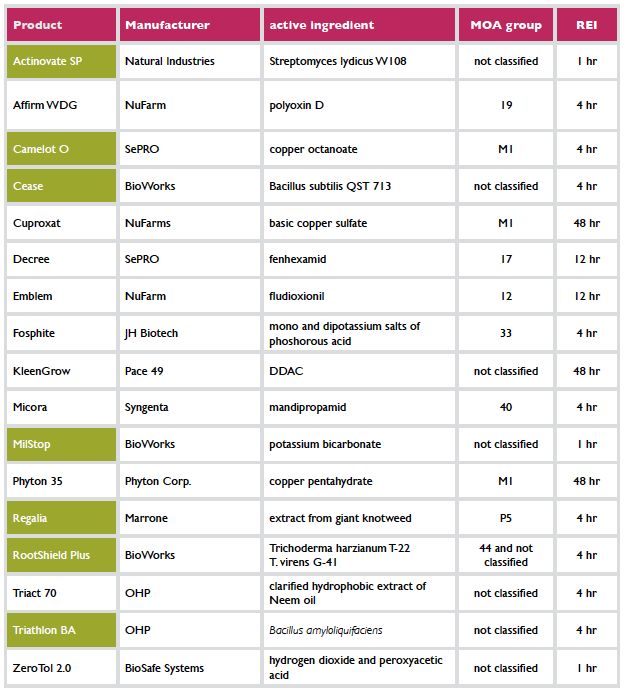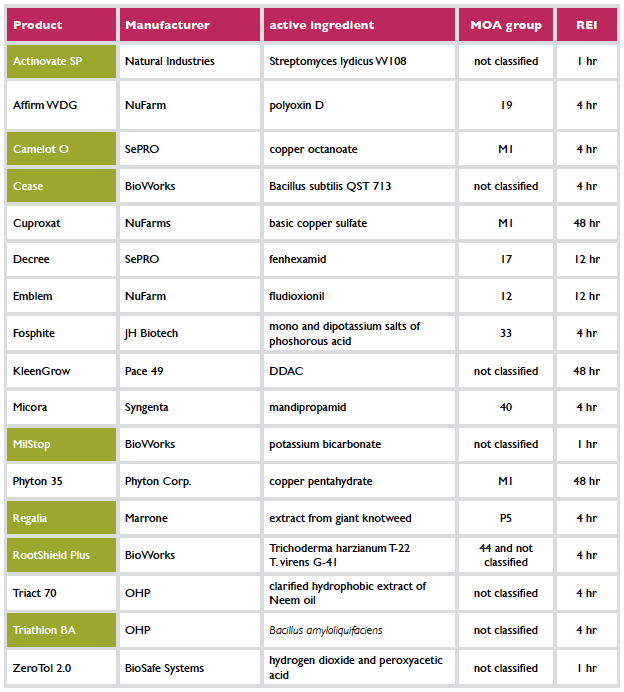
Greenhouse Vegetables: Your Worst Enemies
The majority of the greenhouse vegetables we grow for the end user are produced from seed. Some of us start with plugs from a propagator, but they too must start from seeds. That makes the diseases of vegetables nearly the same as those of bedding plants. Some of them are even exactly the same strains — for instance Botrytis, Pythium and Rhizoctonia. Vegetable seedlings also are grown in mass at times. They are fast growing and exposed to overhead irrigation or rainfall throughout much of their life. Finally, they are not very expensive on a per plant basis relative to crops like potted flowers (mums, poinsettias and orchids).
Vegetable seeds are produced in open fields where plants are irrigated overhead and exposed to rainfall (at least in some locations). The crop is closely planted to favor high seed set, making spread of fungal and bacterial pathogens quite easy.
Flowers themselves are often attacked by the fungi and bacteria, and thus can infect or at least contaminate seeds. Unlike bedding plants and other seed-produced ornamentals, vegetable seeds are often treated. Vegetable seed is commonly treated with effective fungicides/bactericides or even with hot water alone or containing disinfestants (like bleach or peroxide).
Seed-Borne Pathogens
Seed-borne pathogens include fungi like Alternaria, Bipolaris, Cercospora, Colletotrichum, Fusarium, Mycocentrospora, Peronospora and Puccinia. Bacteria including Clavibacter, Pseudomonas and Xanthomonas are also spread by seed contamination.
Xanthomonas leaf spots (tomato, pepper and brassicas) are common in the summer due to the increased overhead irrigation or rainfall and the increased temperatures which easily promote their spread and growth. Pseudomonas spp. can also increase in the summer but are also common in the spring and fall and may be found on watermelon and other cucurbits. All of these leaf spots can be a problem in the container or garden as the plants fill in and leaves stay wet overnight due to summer rainfall or overhead irrigation. Use of sprinkler irrigation and crowding can lead to an outbreak of leaf spots during production or in the landscape anytime. It is not uncommon to find more than one pathogen involved in an outbreak of leaf spot or blight.
Soil-Borne Pathogens
A wide variety of soil-borne pathogens, including Fusarium, Phytophthora, Pythium and Rhizoctonia, are recognized for attacking seeds of nearly all crops including vegetables. However, did you know that Alternaria, Botrytis and Colletotrichum can also cause damping off on greenhouse vegetable plants?
Seed germination is an especially vulnerable step in plant propagation. The advent of the plug industry has taken away some of the risk of germinating your own seed and transplanting them. The very rapid growth of many vegetables has kept some growers in the business of sowing their own seed. Using fungicides to prevent damping off has been demonstrated to reduce percent or speed of seed germination in some crops.
This is minimized by producers who rely on cultural management and biological prevention. Always use new potting medium and containers, and water and fertilize for optimal and not excessive plant growth.
Flats of plugs of ornamentals and vegetables are necessarily irrigated from overhead due to the mass of tiny plants that must be watered a little bit many times a day. The water must be delivered at the top of the pot for best germination, so even if a grower wanted to use subirrigation they would likely have difficulties in the earliest phase of seedling establishment.
Prevention
Once you know what you are facing, you can take the appropriate preventative steps. Preventing everything (even those things that are less likely) is not a sustainable way to grow plants whether you are a producer, farmer, landscaper or gardener. Choosing the right product only when needed is the first step.
In the past five years we have seen many more products registered for use on at least some greenhouse vegetables. The increase in biologicals and other biopesticides that have been approved for organic production has helped many growers.
Since ornamental producers are frequently trying to expand their markets, labeling on vegetables and herbs is of great interest. Some of the products are even OMRI listed and can become a part of an organic program. These include RootShield Plus, Camelot O and Regalia.
Table 1 lists the products that are most recently labeled for use on greenhouse vegetables and herbs. Most of these products are registered with a four-hour REI making them very user friendly. They are quite variable in their activity range from relatively narrow like Micora (Phytophthora and downy mildew only) to Camelot O which can be effective on many foliar diseases including bacterial diseases. Some are also OMRI listed or otherwise labeled for organic production (those with a green box for product). I am also very sure I have missed a few products and I apologize for this oversight on my part. They are not missing on purpose.
We recently completed a tool with BioWorks, “Effective Biopesticide Choices,” which summarizes the most effective biopesticides. The products listed were found to be effective at least somewhat and I listed them in groups of three (different mode of action – FRAC group) for a good rotation. One side is in English and the other is in Spanish. This would be a good place to start when trying to decide what to choose for a rotation on a specific disease. The tool is only available from BioWorks.
Table 1. Some fungicides for use on greenhouse vegetables. Please check the most current label for exact use rates and specific plant labeling. Products in green are OMRI listed or otherwise labeled for organic production.

What are some of the most common problems affecting greenhouse-grown vegetables, and what can you do to avoid, diagnose and treat occurrences?


 Video Library
Video Library 




















